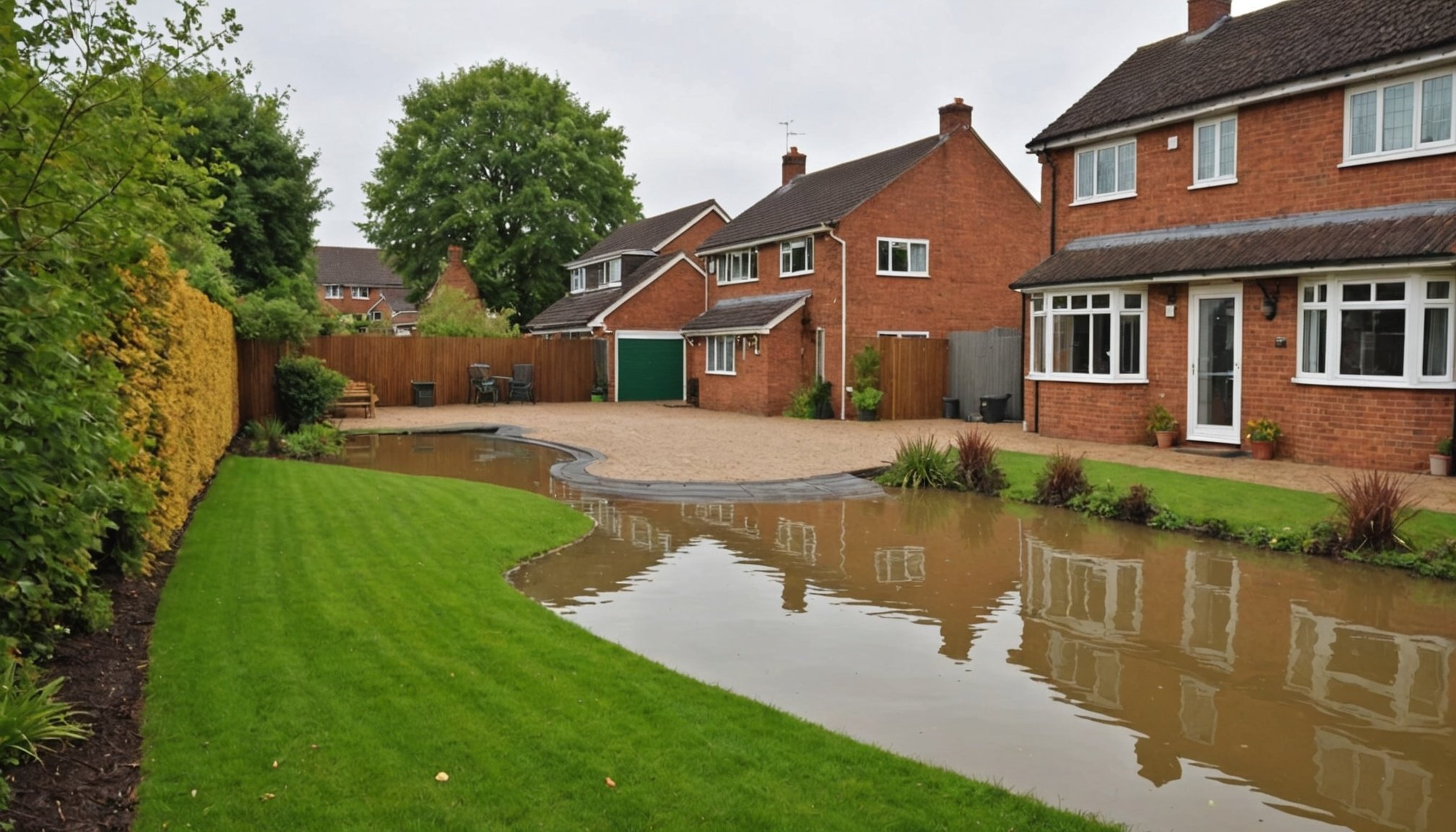Designing Your Landscape to Withstand Floods: A Ultimate Guide for UK Homeowners
As the UK faces increasing instances of flooding due to climate change, designing a flood-resilient landscape has become more crucial than ever. This guide will help you understand the importance of flood-proof landscaping, provide practical tips, and showcase innovative solutions to protect your home and garden from the impacts of flooding.
Understanding Flood Risk and Its Impact on Your Home
Before diving into the design aspects, it’s essential to understand the flood risk associated with your property. The UK Environment Agency provides detailed flood maps and risk assessments that can help you determine if your home is in a high-risk flood zone.
In the same genre : Affordable composting ideas for your cozy uk townhome garden: embrace sustainable living!
“Flood risk is a growing concern for many homeowners, especially with the increasing frequency of extreme weather events,” notes Mary Long-Dhonau OBE, a flood resilience expert. “Understanding your flood risk is the first step towards taking proactive measures to protect your home and garden.”
Here are some key points to consider when assessing your flood risk:
In parallel : Elevate your uk basement: create an unforgettable home theater in low ceilings
- Flood Zone: Check if your property is located in a flood zone using the Environment Agency’s flood maps.
- Surface Water: Be aware of surface water flooding, which can occur when heavy rainfall overwhelms the drainage system.
- River and Coastal Flooding: If you live near a river or coast, understand the risks associated with these types of flooding.
- Insurance: Ensure your home insurance covers flood damage and understand the terms and conditions.
Choosing the Right Materials for Flood-Resilient Landscaping
The materials you choose for your landscape can significantly impact its ability to withstand flooding. Here are some sustainable and flood-resilient options:
Permeable Pavers
Permeable pavers are a sustainable hardscaping solution that allows stormwater to seep into the ground, reducing the burden on storm drains.
“Permeable pavers are installed with layers of varying-sized stone or aggregates underneath that filter and direct stormwater to underground aquifers, mimicking the way natural land absorbs water,” explains Joe Raboine, a landscaping expert[1].
Benefits of Permeable Pavers:
- Reduce stormwater runoff
- Lower carbon footprint
- Available in various styles and designs
- Can be used to harvest and recycle rainwater
Natural Stone
Natural stone is another sustainable option that not only looks beautiful but also minimizes the carbon footprint associated with transportation.
“Opt for locally sourced natural stone to minimize the carbon footprint. Natural stone doesn’t go through a manufacturing process, making it a more sustainable choice,” advises Rosemary Alexander, co-author of “The Essential Garden Design Workbook”[1].
Benefits of Natural Stone:
- Unique rustic look
- Locally sourced to reduce transportation emissions
- No manufacturing process involved
- Can be used for patios, retaining walls, and paths
Gabion Baskets
Gabion baskets are wire mesh containers filled with rocks, concrete, or other materials and offer several eco-friendly and practical benefits.
“Gabion baskets allow water to flow through them, making them an excellent choice for areas prone to flooding or erosion. They also create micro-habitats for small plants and animals,” explains the team at Terrock[3].
Benefits of Gabion Baskets:
- Permeable structure to reduce runoff
- Sustainable materials and local sourcing
- Habitat creation for biodiversity
- Durable and long-lasting
- Versatile in design
Designing a Flood-Resilient Garden
Designing a garden that can withstand flooding involves several key elements:
Rain Gardens and Swales
Rain gardens and swales are designed to capture and filter rainwater, reducing the risk of surface water flooding.
“Community gardens are increasingly at the centre of local water capture and storage, helping to meet the needs of the immediate space but also local people during extended dry spells,” notes the Royal Horticultural Society (RHS)[2].
How to Create a Rain Garden:
- Choose a low-lying area in your garden
- Plant drought-resistant and flood-tolerant plants
- Ensure the garden is designed to slow down the flow of rainwater
- Use permeable surfaces to allow water to soak into the ground
Gravel and Porous Pavers
Gravel and porous pavers are excellent choices for creating permeable surfaces that allow water to seep into the soil.
“Gravel is a good choice for redesigns and bigger projects such as dry gardens or xeriscaping. It is affordable and looks good, while also being beneficial to the environment,” suggests Rosemary Alexander[1].
Benefits of Gravel and Porous Pavers:
- High drainage rate
- Made from 100% recycled plastic
- Longer service life than alternative options
- Softens and greens up larger areas of hardscape
Incorporating Flood Resilience Measures
In addition to choosing the right materials and designing a flood-resilient garden, there are several other measures you can take to protect your home and garden:
Retaining Walls and Gabion Baskets
Retaining walls and gabion baskets can help prevent soil erosion and flooding.
“Gabion baskets excel as retaining walls, especially on sloped terrain. They provide excellent soil retention while allowing proper drainage,” notes the Terrock team[3].
Benefits of Retaining Walls and Gabion Baskets:
- Prevent soil erosion
- Allow proper drainage
- Durable and long-lasting
- Aesthetic appeal
Flood-Proof Plant Selection
Choosing the right plants can also help in flood resilience. Here are some tips:
Flood-Tolerant Plants:
- Trees and Shrubs: Choose trees and shrubs that can withstand flooding, such as willows and alders.
- Perennials: Select perennials like heathers, salvias, and dahlias that require less water and maintenance.
- Ground Covers: Use ground covers like creeping thyme to soften and green up larger areas of hardscape.
| Plant Type | Benefits | Examples |
|---|---|---|
| Trees and Shrubs | Can withstand flooding, stabilize soil | Willows, Alders |
| Perennials | Low maintenance, drought-resistant | Heathers, Salvias, Dahlias |
| Ground Covers | Soften and green up hardscape, low maintenance | Creeping Thyme |
Community Water Butts and Sponge Cities
Community water butts and sponge city initiatives can help in capturing and storing rainwater, reducing the risk of flooding.
“Community gardens are increasingly at the centre of local water capture and storage, helping to meet the needs of the immediate space but also local people during extended dry spells,” notes the RHS[2].
Benefits of Community Water Butts and Sponge Cities:
- Capture and store rainwater
- Reduce surface water flooding
- Provide refuge for people and wildlife
- Help in flood proofing
Practical Tips for Homeowners
Here are some practical tips to help you design a flood-resilient landscape:
Assess Your Site
Before starting any landscaping project, assess your site to understand its drainage patterns and flood risk.
“Respect for the site is fundamental to the doctrine of sustainability,” advises Rosemary Alexander[1].
Use Local Materials
Using locally sourced materials can reduce the carbon footprint associated with transportation.
“Sourcing landscaping materials locally helps lower the high carbon cost of transportation,” suggests Rosemary Alexander[1].
Ensure Proper Drainage
Make sure your landscape design includes proper drainage measures to prevent water accumulation.
“Permeable surfaces help ground water to flow between open spaces in the materials and soak away naturally,” explains Joe Raboine[1].
Consult Professionals
For larger projects or structures bearing significant loads, consult with a landscape architect or engineer.
“Proper installation is crucial for the effectiveness and longevity of gabion baskets. Consider factors such as proper foundation preparation and appropriate sizing and reinforcement,” advises the Terrock team[3].
Case Studies and Success Stories
Here are a few case studies and success stories that highlight the effectiveness of flood-resilient landscaping:
Nick and Annie Lupton’s Flood-Resilient Home
Nick and Annie Lupton built a wall around their home to protect it from the River Severn. Their story is a testament to the importance of proactive flood resilience measures.
“The incredible story of how Nick & Annie Lupton have been fighting the floods and winning is a fascinating read,” notes Mary Long-Dhonau OBE[4].
The RHS’s Sponge City Initiatives
The RHS has been promoting sponge city initiatives to help communities capture and store rainwater, reducing the risk of flooding.
“2025 is expected to see a growth in so-called ‘sponge city’ capabilities as developers and councils increasingly cotton on to the broader benefits of planted spaces,” notes the RHS[2].
Designing a flood-resilient landscape is not just about protecting your home and garden from flooding; it’s also about creating a sustainable and environmentally friendly outdoor space. By choosing the right materials, designing a rain garden, incorporating flood resilience measures, and using local materials, you can ensure your landscape is both beautiful and resilient.
“Flood resilience is not just about protecting your property; it’s about creating a sustainable future for your community,” concludes Mary Long-Dhonau OBE[4].
By following these tips and incorporating innovative solutions like gabion baskets and permeable pavers, you can make sure your garden and home are ready to face the challenges of flooding in the years to come.











